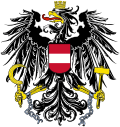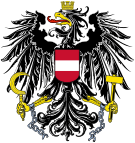
Back رئيس النمسا Arabic رئيس النمسا ARZ Австрия Президенты Bashkir Федэральны прэзідэнт Аўстрыі Byelorussian Прэзыдэнт Аўстрыі BE-X-OLD Президент на Австрия Bulgarian Predsjednik Austrije BS President d'Àustria Catalan Prezident Rakouské republiky Czech Forbundspræsident (Østrig) Danish
| President of the Republic of Austria | |
|---|---|
| Bundespräsident der Republik Österreich (German) | |
 | |
 | |
| Presidential Chancellery | |
| Style | Mr. President His Excellency |
| Type | Head of state Commander-in-chief |
| Status | Supreme executive organ |
| Member of | Presidential Chancellery |
| Seat | Leopoldine Wing, Hofburg Imperial Palace Innere Stadt, Vienna |
| Nominator | Political parties or self-nomination |
| Appointer | Direct popular vote sworn in by the Federal Assembly |
| Term length | Six years, renewable once |
| Constituting instrument | Constitution of Austria |
| Precursor | Chair of the Constituent National Assembly |
| Formation | 10 November 1920 |
| First holder | Michael Hainisch |
| Succession | Line of succession |
| Salary | €349,398 annually |
| Website | bundespraesident.at |
| This article is part of a series on the |
| Politics of Austria |
|---|
 |
The president of Austria, officially titled federal president of the Republic of Austria (German: Bundespräsident der Republik Österreich) is the head of state of the Republic of Austria. Though theoretically entrusted with great power by the Constitution, in practice the president is largely a ceremonial and symbolic figurehead.
The office of the president was established in 1920 following the collapse of the Austro-Hungarian Empire and the Habsburg monarchy in 1918. As head of state, the president succeeded the chair of the Constituent Assembly, the post-monarchic provisional legislature. Originally intended to be chosen directly by the Austrian people through universal suffrage every six years, the president was instead appointed by the legislative Federal Assembly until 1951, when Theodor Körner became the first popularly-elected president. Since the institution of the popular vote, only nominees of the Social Democratic Party and the People's Party had been elected to the presidency, with the exception of the Green-endorsed incumbent Alexander Van der Bellen.
The president appoints the chancellor, the vice chancellor, the ministers, the secretaries of state, and the justices of the Supreme Courts. The president can also remove the chancellor and the Cabinet at any time. Additionally, the president signs bills into law and is empowered to dissolve the National Council and the state legislatures, sign treaties with foreign countries, rule by emergency decree, and command the Armed Forces. However, most of these presidential powers have never been applied. Furthermore, the president ranks first in Austria's order of precedence, ahead of the presidium of the National Council and the chancellor.
The principal residence and workplace of the president is the Leopoldine Wing of the Hofburg Imperial Palace, situated in Vienna.
© MMXXIII Rich X Search. We shall prevail. All rights reserved. Rich X Search

